Car accidents are scary, and in worse-case-scenarios, they can produce serious injuries or even death. Alabama has the third-highest fatality rate of all fifty states, making it one of the most dangerous states for drivers and passengers. In most cases, a motorist who sustains injuries or property damage in an accident may sue the other driver for damages.
You may have sustained injuries yourself, as well as damages to your vehicle, and now facing the prospect of a lawsuit is stressful and frightening. Knowing what to do in the immediate aftermath of a car accident can make a significant impact on the outcome.
Alabama is A Fault State—What Does that Mean
If the other driver attempts to sue you, you may feel overwhelmed and have no idea how you should proceed. You should contact your insurance company once you realize you are being sued. If you are insured, the insurance company should have made every effort to settle with the other driver on your behalf.
Drivers are legally accountable for injuries and damages that occur due to their negligence. In Alabama and other fault states, injured drivers have numerous ways to pursue a claim for compensation for the damages they suffered. Injured drivers, or drivers who suffered other damages, can file a claim against the at-fault driver’s insurance company, file with their own insurance company, or file a lawsuit.
How to Determine Who is At-Fault in an Accident?
To receive compensation, the driver who brings the suit must prove that you acted negligently. Sometimes, the facts of the accident are clear, and the fault is evident. Some accidents, however, require an in-depth investigation to determine all the factors that contributed to the accident.
For a plaintiff to prevail in proving that you acted negligently, there are several things that they must prove for their claim to be successful. These include:
- Duty—the other party must prove you owed them a duty of care, which is true in most automobile accidents. You owe a duty of care to other drivers and passengers on the road
- Breach of Duty—Once establishing that you owed them a duty, they must then prove that you breached that duty
- Causation – Your actions caused the plaintiff harm
- Damages—The plaintiff must prove they were injured and suffered some loss
Evidence about the accident, such as photographs, disobeyed traffic laws, witness statements, and the property damage, are all crucial to determining who is at fault. Remember, until you have spoken with an attorney, who should be provided by your insurance company, it is essential never to admit fault.
Note that Alabama is a contributory negligence state. This means that sharing any degree of responsibility for an accident will bar a financial recovery. Just sharing So, it’s often in your best interest to find a way to allocate some of the blame to the person who’s sued you. If they share just one percent of the blame, damages are off the table.
If an investigation determines that you are responsible, and your negligence was the sole cause of the accident, the other driver could potentially file a lawsuit and receive compensation.
What Do I Do When the Accident Was My Fault?
If the collision was your fault and you were insured at the time, your insurance company would likely cover the other driver’s damages based on the limits of your insurance policy. Please be aware your insurance company will likely attempt to pay as little as possible. Their job is to protect their own interest and protect their bottom line.
If you are served with notice of a lawsuit, you need to contact your insurance company as soon as possible. You will need to provide them with a copy of the suit. The insurance company will have to defend the suit. If you encounter issues with your insurance company or feel that they have acted in bad faith, you should contact an Alabama attorney for advice on your rights.
What to Do Immediately After an Accident?
Automobile accidents can happen in the blink of an eye, and those few seconds before and during impact are often violent and unexpected. It is not uncommon to be somewhat disoriented or confused about what happened, especially if the wreck was brutal. Knowing what to do beforehand helps you take clear and decisive action, even when adrenaline and fear are pouring through you.
- Immediately after a crash, follow these essential steps:
- Call 911 immediately and report any injuries
- Check on the other driver if you can do so safely
- If your vehicle is drivable, move it off the roadway to the nearest safe distance
- When the police arrive, tell them what you remember about how the accident occurred. However, do not admit fault or blame anyone else for the accident
- If it is safe to do so, take pictures or videos of the crash scene
- If the crash was severe enough to warrant EMS, let them check you out for physical injuries
- Exchange driver information and contact information for witnesses
- If they recommend transport to the hospital, do so
- If you feel symptoms of injuries later, do not hesitate to seek immediate medical attention
- Do not speak to anyone other than the police regarding the accident
- Obtain a copy of the accident report
- Notify your insurance agency of the accident
One important tool is to take detailed notes immediately after the accident. You can use your phone to type out everything you remember. Take notes about any witnesses to the accident, their contact information, and nearby businesses whose video cameras may have caught the accident on tape.


